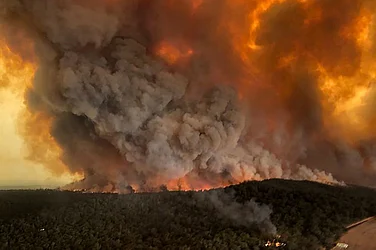Social media has been flooded with posts of a so-called 'planet parade' that will apparently be "visible to the naked eyes" in the skies across the globe on Monday, June 3, something that is being touted as a "rare" phenomenon but is not necessarily so as per experts.
Amid the world obsessing over the June 3 'planet parade', NASA and even the Indian Institute of Astrophysics (IIA), Bengaluru, have debunked theories being circulated via social media.
About 'Planet Parade'
Social media is abuzz with claims that six planets - Saturn, Mars, Jupiter, Mercury, Neptune and Uranus - will align in a straight line on June 3, giving a rare visual treat to skywatchers. The phenomenon is going viral on social media with the phrase "parade of planets" associated to it.
While social media chatter and multiple reports call the phenomenon "rare" and say it will be visible only on June 3, NASA and other experts have debunked the claims.
Planet Parade: 6 Planets Won't Be Visible On June 3, Says NASA
In a note, the National Aeronautics and Space Administration (NASA) said that while "some online sources have shared excitement about a parade of planets" visible in the morning sky in June 3, in reality, only two of the six planets supposedly on display - Saturn and Mars - will actually be visible.
"In early June, Jupiter and Mercury will be at or below the horizon in morning twilight and not visible; Uranus and Neptune are far too faint to see without a telescope, especially as the morning sky brightens," NASA said.
The closest thing to a planet parade will be June 29, when Saturn, the Moon, Mars, and Jupiter will line up across the morning sky, it said.
Planet Parade: 'Not So Rare'
The Indian Institute of Astrophysics in Bengaluru also said that the phenomenon cannot be termed as rare as such alignments can be seen every few years.
"For one, it is not exclusively on June 3. These planets can be seen aligned over many days in the coming week," said Niruj Mohan Ramanujam, head, IIA’s SCOPE section.
According to him, on the days before June 3, Jupiter is closer to the Sun and after June 3, Mercury gets closer to the sun, hence June 3 is optimal. "You can go out before sunrise every day in the coming week and try and spot as many planets as you can," news agency PTI quoted Ramanujam as saying.
Parade Of Planets: 'Only 2 Planets Can Be Seen With Naked Eyes'
According to a series of social media posts debunking many theories being circulated via social media, IIA said that in the coming week, people can see yellowish Saturn clearly, high up in the Eastern morning sky, with the reddish Mars halfway below. IIA said that the other planets part of the so-called 'parade' won't be visible to naked eyes due to their closeness to the sun.
The rest of the planets that are supposed to be visible during the planet parade, will not be easy to spot, Ramanujam said.
"About 20 minutes before sunrise, Jupiter and Mercury will be less than 10 degrees above the Eastern horizon. Uranus and Neptune, as always, are too faint to be seen with naked eyes. Venus will appear too close to the Sun," Ramanujam added, dismissing the buzz on social media that the planets are aligned in a straight line only on June 3.
"The orbits of the planets around the Sun are roughly in the same plane, and each of them are inclined by only a few degrees from the Ecliptic [Earth’s orbit]. Hence, when seen from the Earth, the planet positions will be roughly along a plane at all times," said Ramanujam.
He said this event cannot be termed as rare as such alignments can be seen every few years. "The occasions where more than three to four planets are on one side of the Sun, and are closer to each other than usual, are called planet parades," he said.
However, Ramanujan also said that rare or not, it is always a treat to see the planets with our naked eyes. "It really is a pretty sight. But just remember, if you oversleep on June 3, you can always get up early the next day to catch up on the show," he added.


























